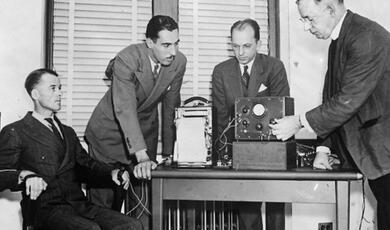Dementia: At Risk of Being Forgotten?
Share
- Details
- Text
- Audio
- Downloads
- Extra Reading
The remarkable improvements in child health, cardiovascular disease and cancer survival over the last few decades have not been replicated in dementia. As populations age, inexorably the burden of dementia, mainly a disease of ageing, is steadily increasing. The scientific understanding of dementia has advanced, but if the current slow rate of improvement in prevention and treatment is maintained, the burden of dementia will increase substantially over the next few decades.
Advances in prevention and treatment of dementia in the elderly, including Alzheimer’s, are painfully slow despite the scale of the problem. Is this a failure of science, of the will of our generation to tackle a problem restricted to the elderly, or do we need to accept that it will just happen and plan to minimise its inevitable substantial impact on individuals, families and society?
Download Text
27 April 2016
Dementia:
At Risk of Being Forgotten?
Professor Christopher Whitty
Dementia is much feared but, like cancer before it, people have started talking more openly about it recently. It has been sympathetically portrayed for example in the recent films “Mr Homes”,” Still Alice” and the book “Elizabeth is missing”. Dementia can happen to people with remarkable memory and mental capacity. In this lecture we will consider the epidemiology of dementia, some of the dementias where we are winning, how different dementias affect the brain, the major dementias of old age, living with dementia and then looking to the future.
If we look at the 10 leading causes of deaths in males and females in England and Wales we can see that whilst many major causes, particularly the cardio-vascular diseases stroke and heart attacks have been falling rapidly, dementia as a proportion of deaths is beginning steadily to rise (Figure 1, UK female deaths 2003-2013. ONS data).
This rise is due to the aging of the population, combined with improvements in health in other areas such as heart disease so their relative proportion has gone down. Dementia arguably is one of the leading causes of ill health where we are moving most slowly.
It is important to understand that there are some significant risk factors for dementia but by some distance the most important is age, which is why it is in this series on medicine at the extremes of life. There are some rare causes of very early dementia, but dementia under the age of 65 is very rare. The risk from then on gradually increases from around 1.7% in the 65-69 year old age band, up to 18% (roughly one in five people) in the age band 85-89. Even in those aged over 95 the majority of people do not have dementia (41% are estimated currently to do so). The majority is mild dementia. Females in the very old age groups (over 90) tend to be more affected than males. Studies that compare dementia rates at two different points in time suggest that the rate of new dementia cases is decreasing over time once you standardise for age, but that much of that difference is a reduction in men (Figure 2, UK dementia incidence in men 20 years apart. Mattews et al, 2016). There will however still be an increase in the prevalence of dementia (the proportion of the population living with dementia) due to the aging of the population.
There are a number of elements of dementia which are widely misunderstood. Important ones are an assumption that all dementia is Alzheimer’s; that dementia is synonymous with memory loss; that it cannot be combated. The last of these has proved historically incorrect for many causes of dementia which are now rare. In Sir Thomas Gresham’s time a new major cause of dementia was sweeping Europe. Syphilis arrived in the UK almost exactly a century before Gresham College was founded. It rapidly became very common and remained so until the dawn of the antibiotic era. A Royal Commission in 1916 estimated that no less than 10% of people in London had it. Around 7% of people would get a form of dementia called General Paralysis of the Insane as a late complication (around 10 or more years after initial infection). This cause of dementia is now virtually unknown thanks to antibiotics. Within the lifetime of most of this audience a new viral cause of dementia took off, HIV. Before antiretroviral drugs 20-30% of people with advanced HIV developed dementia. This figure has now decreased to around 2% where treatment is available. Different geographies have historically had different forms of dementia, for example in Africa a major parasitic cause of dementia was Sleeping Sickness. There were areas of the continent where 50% of people living in a village had the disease at its peak. It is now down to less than 10,000 reported cases and could even be eliminated in our lifetimes. The UK was the country where the last major new infectious cause of dementia arose. The BSE crisis led to tragic cases of Variant CJD (vCJD). This was caused by prion infections jumping the species barrier. Removing neurological tissue from the food-chain and culling infected animals halted this epidemic although there are still occasional tragic cases from people who became infected before the measures were in place.
It is not just infections. Chemicals widely used in industry used to cause dementias of which probably the most well-known, because people come across it in children’s books, is mercury poisoning, causing Hatter’s Shakes from which the character of the Mad Hatter arose. It is not just things getting into the body which cause dementia but also absence of important nutritional components. The most recent major epidemic of this in the Western World was Pellagra due to niacin deficiency (Vitamin B3). It occurred in the USA in people who had a diet largely consisting of maize (corn). Between 1906 and 1940 more than 3 million Americans were affected by it with more than 100,000 deaths. Dementia is one of the serious manifestations of Pellagra. There remains some controversy over the place of Vitamin B12 and folate now.
These are examples where a cause of dementia which previously was a major public health problem has been almost entirely eliminated by a combination of scientific discovery followed by public health action. Our aim must be to make sure that in our generation we lay the foundations which will allow similar public health action based on science to tackle these three remaining major classes of dementia all of which affect primarily the elderly. It is important to acknowledge, however, that there are some rare causes of early dementia, several of which have a very strong genetic linkage. Familial early onset Alzheimer’s affects less than 1000 known families worldwide but in around half of these, dementia will occur early in life. Huntingdon’s disease is another well-known rare genetic cause of dementia in middle age. Children born with Down’s syndrome who survive to adulthood are also at substantially increased risk of early dementia. Almost all of the disease, however, is in public health terms in the elderly, in our generation, in industrialised countries.
Dementia is therefore not one disease. It has many causes and only a few are common. It is very different from the other neurological diseases we have considered in this series of major stroke – it is insidious in onset rather than sudden and it tends to be associated with widespread reduction in brain capacity rather than a single discrete area. Memory is affected in most dementias eventually but is often not the main or first symptom. It is also likely that major causes such as Alzheimer’s dementia will in due course be identified as several diseases requiring different treatments.
To understand the dementias of old age it is important to have a basic understanding of different parts of the brain. Many parts of the brain are involved in conscious thought. These include the frontal lobe involved in planning, judgement, attention span and inhibition; the parietal lobe involved in speech, visual integration, perception of space and attention and the temporal lobe which includes auditory processing, facial recognition and language recognition. Damage to any of these can cause dementias but what the main manifestations of the dementia will be depends on where they begin.
One of the difficulties in tackling dementia scientifically is that memory is a very complicated subject. Much of what follows in the rest of this lecture is based on our current understanding of science, but it should not be considered to be settled science in the way that much of what I have talked about in previous lectures is, and some areas remain controversial. A future lecturer in Gresham College 50 years hence giving a talk on dementia will probably have a very different theoretical understanding as more science emerges. Common to theories of memory are that there is a short term and a longer term memory. Short term working memory is what allows us for example to remember a telephone number before we write it down. Longer term memories are laid down which last long periods including life-long. This includes explicit memories which are conscious for things like facts and events and implicit memories for things like skills and tasks like riding a bicycle or tying your shoelaces. There are also specialised memory functions that reside in particular parts of the brain including memory of faces and for music.
Many structures of the brain are involved in conscious memory, which is highly dispersed. These include the hippocampus - a very important part of the memory system. A surprisingly large amount of what we know about it came from the study of a single man who had it surgically removed to control epilepsy. It is very important in laying down memories and while moving them from short term to long term and retrieving them. The frontal lobe includes several bits of memory including working memory. Memory is not just structural; there is now reasonable evidence for education and intelligence in childhood being associated with delayed onset of dementia (cognitive reserve). Memory does become less sharp in old age in many people without dementia. Classic examples are prospective memory tasks – remembering to perform an act at a future time. These are not likely to progress substantially and they are usually relatively simple to work around e.g. with a diary.
In old age there are several dementias but three predominate. The first is Alzheimer’s disease, which causes the majority of dementia in the elderly in this era. The second is vascular dementia. The third is the spectrum between dementia with Lewy bodies (DLB) and Parkinson’s disease associated dementia which are a spectrum. Some people have a mixed dementia and then there are a number of rarer causes which will not be covered in this lecture.
I will start with vascular dementia since this is closest to the last lecture in this series which was on stroke. There are three broad presentations of vascular dementia but the thing they have in common is that because the blood vessels are not giving sufficient oxygen to the brain, brain cells die. The first is after a major stroke. Dementia can develop weeks to months after stroke at a relatively rapid process. At the other extreme is small vessel disease which is thought to be where the small arteries of the brain gradually become less proficient. This tends to be a gradual process. Between these two, and probably much rarer, is multi infarct dementia where a number of very small strokes, none of which is necessarily a major handicap in itself, give rise to dementia in a stepped fashion. The initial symptoms of dementia in vascular dementia depend on where the strokes or vascular disease are. Frontal lobes or the sub-cortical area tend to lead to problems with planning and sometimes behaviour being early manifestations. In temporal or parietal lobe problems memory may be affected earlier.
Preventing vascular dementia has a much less good evidence base than for stroke but it seems highly likely that the things which work to reduce stroke and other diseases of the circulation are also important for the dementias. These include stopping smoking, reducing hypertension, anticoagulation in atrial fibrillation, exercise and possibly reducing cholesterol and alcohol. There is no doubt that strokes have decreased steadily over the last few decades and continue to do so and it may well be that some of the improvement seen in dementia by age in a number of studies, especially in men, are due to reductions in vascular dementia.
Alzheimer’s disease, the most common dementia in high-income countries, was first described in 1906 including the cell damage. There are around 50 million cases worldwide and rising. Clinically it does start with memory impairment but over time can progress to widespread brain damage and dysfunction which may take years. It is thought the reason that memory is affected is that Alzheimer’s generally starts near the hippocampus, the area that is associated with laying down memory. Working and long-term memory are initially relatively preserved. As it progresses it begins to affect the frontal lobes and this can lead to the beginnings of difficulty thinking and with behaviours. There are certain features of the brains of those who have had Alzheimer’s disease which have been well known from early in its discovery. The first is amyloid beta plaques which are clumps of protein fragments that accumulate around and damage and kill brain cells. The second are neurofibrillary tangles which are twisted fibres of tower protein that build up inside the neurons of Alzheimer’s patients. Both are normal proteins. There is a gradual built up over many years starting around the hippocampus. In reality the exact mechanism of damage, and indeed whether the amyloid plaques are the problem, or simply a marker of disease, is not yet entirely clear. There is however a very clear association between amyloid deposition and Alzheimer’s disease. It is likely that amyloid will become one of the drug targets for those designing drugs to combat Alzheimer’s. Amyloid can also be picked up in scans and it is there helpful in distinguishing Alzheimer’s from other forms of dementia. More recent data do suggest however that whilst there is a very strong association between amyloid plaques around the hippocampus with dementia in the younger old aged (65-85), in the very elderly this association decreases. It may well be therefore that classical Alzheimer’s as we understand it is not the cause of dementia occurring in the very elderly.
Currently we have no drugs to treat Alzheimer’s but we do have some to partially reduce the symptoms in some people. The most important group are the cholinesterase inhibitors. In Alzheimer’s disease there are low levels of the neurotransmitter acetylcholine. The drugs inhibit enzymes that break down acetylcholine and therefore lead to raised brain levels. There is a separate kind of drug memantine which helps block a neurotransmitter, glutamate, which is thought to be harmful in Alzheimer’s. The three cholinesterase drugs and memantine all seem to work roughly equally effectively. 40-70% of people with Alzheimer’s benefit from taking the drugs and symptoms improve for 6-12 months before gradually going back on a downward declining path again. However, there is more recent evidence that they do continue to have beneficial effects for quite some time afterwards. It should be clear, however, that these drugs do not change the progression of the disease; they simply reduce some of the symptoms in the same way that a Paracetamol reduces a fever without curing an infection.
The real target has to be drugs to slow, halt or even reverse Alzheimer’s. This is more difficult than for many other areas in particular because the diagnosis of Alzheimer’s and the end point for trials are much more indistinct than for say stroke or heart attacks. The biology is also much less well understood than for many diseases for which we now have good treatments. There is a mouse model of Alzheimer’s disease but it is not clear how good it is at reflecting human disease. Drug companies have also been deterred by several costly failures. Several drugs could in theory slow or attack the amyloid plaques, and the tau tangles are another potential target some of these are chemical and some are immunological. We know from drugs targeting other kinds of amyloid in the body that this is in principle possible. If the amyloid is the basis for disease (and this is controversial) then in principle this should slow or halt the disease. The amyloid plaque/tangle theory as to what causes Alzheimer’s will be tested once the first drugs are available.
A completely separate line of investigation, but quite a long way behind, is the use of neural stem cells to try and repair some of the damage caused in Alzheimer’s.
The associations for modifiable risk factors for Alzheimer’s are surprisingly similar to those for cardio-vascular disease although the link is less clear-cut. These include evidence associating it with lack of exercise, obesity, smoking, diabetes, high cholesterol and excess alcohol. What is not clear is how much modifying these over time, and at what stage of life, would lead to a reduction in Alzheimer’s. However it seems sensible for Alzheimer’s as for many other diseases to follow advise which would be recognisable as good health advice more generally: exercise, lose weight, stop smoking, keep mentally active, moderate alcohol intake, reduce blood pressure and take statins where indicated.
A major concern people have particularly when they have a family member with dementia or have dementia themselves is that they will be passing on Alzheimer’s to their children. There is a genetic link to Alzheimer’s but other than early Alzheimer’s it is not inherited in the normal sense that people understand it. Risk roughly doubles with a cloes relative, but from a low base. Many genes are associated with this. The main one is Apolipoprotein E also known as ApoE. There are three forms of this E2 is mildly protective, E3 is the commonest, and E4 is the one associated with risk. In the UK around 25% of people get one E4 gene which slightly increases their risk of dementia. Two percent get two E4 genes and that increases their risk 10x. It is important to stress that most people with one E4 gene will not get Alzheimer’s in normal current lifespan and genetics probably determine when people get dementia rather than whether they do.
The final dementia to cover is dementia with Lewy bodies. The brain pathology is similar to Parkinson’s disease and practically it is a spectrum between Parkinson’s disease and Alzheimer’s disease. Post mortem studies show protein clumps in the brain: when these are in the base of the brain, people have tended to exhibit Parkinson’s disease, and in the outer layers of the brain they tend to have Lewy body dementia. Analytical functions of the brain tend to be reduced early and memory may be affected late. One significant difference from Alzheimer’s is that it tends to fluctuate very substantially and visual hallucinations are relatively common. Drugs to prevent or treat the disease are likely to be different from Alzheimer’s. There is a less clear genetic component.
It is important to stress that dementia treatment is currently not mainly about drugs. Keeping people stimulated, memories, music, dance, enough light, uninterrupted mealtimes and minimising the gap between realistic expectations and current reality as well as planning for the future are all examples of things that can help in dementia. One thing in particular to look out for is depression. Dementia can initially be mistaken for depression, and depression can look like dementia. In these situations, treatment may help. People living with dementia initially have mild disease. Memory and word finding may be impaired and they may be less confident but otherwise they are as they were. They (we) may have a good quality of life if life can be structured to accommodate this. Severe dementia is a minority. Memory of important people, personality and inhibition may be severely impaired. Anger, aggression and emotional communication can be extremely distressing for relatives. Maintaining dignity for people living with severe dementia and supporting their carers and family are very important.
Looking to the future it is important to remember that the distribution of old age in the UK is far from even. In some areas particularly central cities the age structure of the population will change very little over the next three decades. Other areas of the UK will age extremely fast and the burden of dementia care will have to fall in these areas, especially amongst women. Dementia raises a number of legal and ethical issues. One of the most important for science is that ethical standards for expecting consent for trials are gradually increasing yet people with dementia, particularly severe dementia, cannot give consent in the ordinary way. Professionalisation of caring for dementia in care homes also gives rise to some really difficult ethical questions. Historically dementia research has been less well funded, and had less interest from scientists than the future burden suggests it needs but recently the UK and others have started to invest in it much more seriously.
In dementia our worst times but also our best times are ahead of us. The classical infectious and nutritional causes of dementia are largely gone in high income countries and are dropping fast in low-income countries. It is likely vascular dementia will partially retreat as stroke has done because the risk factors are likely to be similar. Alzheimer’s dementia and dementia with Lewy bodies will increase because of the aging population until science finds ways to prevent, halt and possibly reverse them. A five year delay might reduce population prevalence by up to 50%. This is, in my view, a matter of when not if, but if we do not lay the scientific foundations now this burden will only keep on increasing.
© Christopher Whitty 2016
Part of:
This event was on Wed, 27 Apr 2016
Support Gresham
Gresham College has offered an outstanding education to the public free of charge for over 400 years. Today, Gresham College plays an important role in fostering a love of learning and a greater understanding of ourselves and the world around us. Your donation will help to widen our reach and to broaden our audience, allowing more people to benefit from a high-quality education from some of the brightest minds.


 Login
Login







